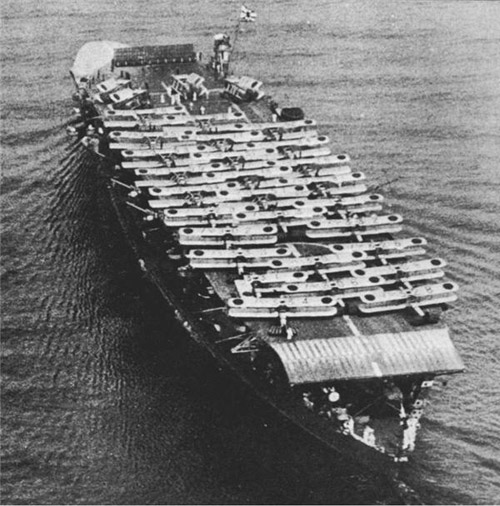Akagi-class
Summary
| Origin country | 🇯🇵 Japan |
| Category | Aircraft carrier |
| Subtype | Fleet heavy carrier (World War II) |
| Manufacturer | Kure shipyards |
| Year commissioned | 1927 |
| Approx. unit cost | $36.45 million |
Description
Akagi was an aircraft carrier of the Imperial Japanese Navy (IJN), named after Mount Akagi and originally laid down as an Amagi-class battlecruiser. To comply with the Washington Naval Treaty, her construction was altered to an aircraft carrier. Akagi was rebuilt from 1935 to 1938 with a single enlarged flight deck and an island superstructure, emerging as the IJN's first large "fleet" carrier. She played a significant role in developing the IJN's carrier striking force doctrine, which was pivotal in early Pacific War successes.
Before World War II, Akagi's aircraft were active in the Second Sino-Japanese War. Akagi became the flagship of the Kido Butai (First Air Fleet), leading attacks on Pearl Harbor, Darwin, Rabaul, and the Dutch East Indies from December 1941 to early 1942. She was instrumental in the Indian Ocean Raid where British naval forces were targeted.
In June 1942, during the Battle of Midway, Akagi was irreparably damaged by an air strike from USS Enterprise. With the situation irretrievable, she was scuttled by Japanese destroyers. The loss of Akagi and three other Japanese carriers at Midway was a significant defeat for Japan, contributing to the eventual Allied victory in the Pacific.
Originally designed as a battlecruiser, the conversion to an aircraft carrier created unique features such as three flight decks. Post-reconstruction in the mid-1930s, Akagi had two enclosed hangar decks and a single flight deck. Her armament included ten 20 cm guns, anti-aircraft guns, and a complement of around 60 aircraft. Despite a powerful engine and speed, Akagi had design flaws, including directly incorporated aviation fuel tanks and a vulnerable hangar and flight deck, which later proved to be catastrophic.
Akagi's operational history included service under captains like future Combined Fleet commander Isoroku Yamamoto. Its air group underwent continual training and adaptation, reflecting evolving Japanese naval air tactics. The carrier's participation in major operations throughout 1941-1942 demonstrated the strength and weaknesses of the IJN's approach to carrier warfare.
Operating exclusively for Japan, Akagi underwent changes in its aircraft complement and weaponry in response to the needs of the IJN. These changes mirrored the shift in Japanese naval doctrine, which transitioned from considering carriers as support for battleships to recognizing them for their strike capability.
In 2019, the Research Vessel Petrel discovered Akagi's wreck, and it was revisited in 2023 by the research vessel EV Nautilus, which found the ship largely intact at its deep resting place.
Technical specifications
| Akagi | |
|---|---|
| Displacement | 42000 tons |
| Range | 18000 km at 15 knots |
| Crew | 1,630 members |
| Width | 31.32 m (102.8 ft) |
| Length | 260.67 m (855.2 ft) |
| Air Park | 18 A6M Zero fighters, 18 D3 Val dive bombers, 27 B5N Kate torpedo bombers (+25 reserve aircrafts) |
| Propulsion | 19 Kampon steam turbines with a power of 133,000 hp - 4 propellers |
| Armament | 10 200 mm guns + 12 120 mm guns + 28 25 mm AA guns |
| Maximum speed | 32 knots |
Photo of Akagi class
